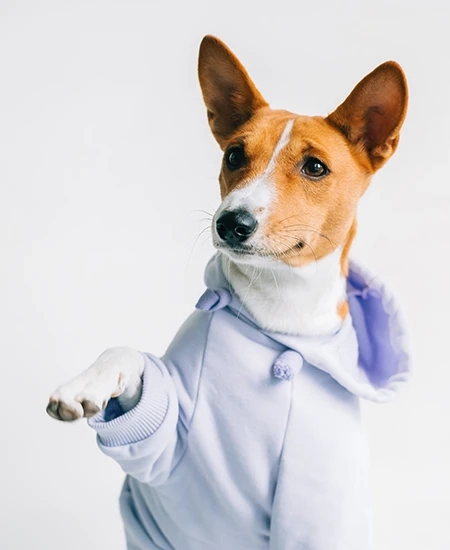As more pet owners embrace dressing up their furry companions, dog clothes are becoming more common than ever. Whether it's a cozy sweater for cold days or a costume for special occasions, many dogs can benefit from wearing clothing. However, not all dogs take to it naturally. Some may feel confused, stressed, or even refuse to move once dressed. The good news? With the right approach and a bit of patience, you can get your dog comfortable with wearing clothes.
In this guide, we'll explore the steps you can take to help your dog adjust, what to avoid, and why it might be useful—especially if your pet attends doggy day care or lives in a cooler climate.
Why Put Clothes on Your Dog?
Comfort and Warmth
Some dogs, especially short-haired breeds or smaller dogs, get cold easily. Dog clothes like sweaters or jackets can help keep them warm during chilly walks or indoors with the air conditioner running.
Protection
Certain outfits protect dogs from environmental elements such as sun, rain, or snow. Clothes can also prevent dirt, allergens, or insects from irritating your dog’s skin.
Style and Fun
While fashion isn’t essential, many owners enjoy dressing their pets up for holidays or events. In doggy day care settings, themed dress-up days are becoming increasingly popular and offer a fun social experience for pets.
Medical Reasons
Dogs recovering from surgery or skin conditions may wear clothes to prevent them from scratching or licking their wounds, offering an alternative to the dreaded cone.
When to Start Dressing Your Dog
Start Young If Possible
Puppies are generally more adaptable to new experiences. If you begin introducing clothing at an early age, your dog is more likely to accept it as part of normal life.
But It’s Never Too Late
Older dogs can still learn to wear clothes with patience and the right techniques. It might take a bit more time, but it’s absolutely possible.
Step-by-Step Guide to Getting Your Dog Used to Clothes
Step 1: Choose the Right Clothing
Start with soft, lightweight dog clothes that don’t restrict movement. Avoid zippers or buttons that could press into your dog’s skin or get caught in fur. Look for clothes designed specifically for dogs, with openings in the right places for potty breaks.
Step 2: Let Them Sniff It Out
Before putting anything on your dog, let them inspect the clothing. Allow your dog to sniff, paw, and examine the item. This helps reduce fear or anxiety about an unfamiliar object.
Step 3: Use Positive Associations
Every time you introduce the clothes, reward your dog with treats, praise, or playtime. This helps create a positive association with the outfit.
You can also place the clothes near your dog’s bed or feeding area so they become a normal part of the environment.
Step 4: Start Small
Don’t rush to put on an entire outfit. Begin with simple accessories like a bandana or a lightweight t-shirt. Let your dog wear it for a few minutes, then gradually increase the time as they get used to it.
Step 5: Watch Body Language
Observe your dog’s behavior while they’re wearing clothes. Signs of distress such as tail-tucking, whining, stiff posture, or attempts to remove the clothing should be taken seriously. Remove the clothes and try again later.
Step 6: Keep Sessions Short
At the beginning, only keep clothes on your dog for a few minutes. Slowly extend the time each day as your dog becomes more comfortable.
Step 7: Make It a Routine
Practice putting on dog clothes regularly, even if it's just for a few minutes. Consistency helps your dog become more familiar and less reactive.
Common Mistakes to Avoid
Forcing Clothes On Too Quickly
Never rush the process. Forcing a dog into clothing before they’re ready can make them fearful and resistant in the future.
Ignoring Discomfort
If your dog clearly dislikes a certain fabric, fit, or design, don’t persist. Try a different style that might be more comfortable.
Using Clothes as Punishment
Clothes should always be associated with positive experiences. Never use them as a form of control or punishment.
Not Considering the Fit
Ill-fitting clothes can restrict movement and cause discomfort. Always check sizing guides before purchasing dog clothes, and ensure there are no tight areas or dangling parts that might get chewed or tangled.
Training Tips for Specific Types of Dog Clothes
Sweaters and Jackets
These are among the easiest clothing items for dogs to get used to, especially if they’re soft and fitted. Introduce them during colder seasons when your dog might naturally appreciate the extra warmth.
Costumes
Costumes can be bulkier or include extra features like hats or wings. Only use costumes for short periods, and ensure your dog is already comfortable with simpler outfits before attempting.
Costumes are often used during celebrations or at doggy day care themed events, so it's a good idea to train in advance.
Boots or Shoes
Some dogs dislike anything on their feet. To get them used to wearing boots, try putting one boot on for a few minutes at a time and reward them for walking in it. Gradually work up to all four.
Raincoats
Many dogs dislike rain. A well-fitting raincoat can encourage them to go outside during bad weather. Choose waterproof material with a secure but comfortable fit.
Special Considerations for Doggy Day Care
Why Clothes Matter at Doggy Day Care
If your dog spends time at a doggy day care, clothing can serve both practical and social purposes. Outfits can help staff identify dogs quickly, keep them clean, or prevent small injuries during play. Plus, many facilities host dress-up days and social media photo sessions, making your well-dressed pup a star.
Ensuring Safety in Group Settings
When sending your dog to doggy day care in clothes, choose simple outfits that won’t snag or tear during play. Avoid accessories like dangling hoods, scarves, or hats unless they’re being supervised.
Let staff know your dog’s comfort level with clothes. They can monitor interactions and ensure your dog isn’t stressed or targeted by other dogs due to their outfit.
What If My Dog Never Likes Clothes?
Some dogs simply don’t enjoy wearing clothes, and that’s okay. You can still keep them warm and protected in other ways, like using blankets or limiting time outdoors during extreme weather.
Respect your dog’s individual personality and preferences. Not all dogs will become fashionistas, and forcing the issue can create anxiety and harm trust.
Signs Your Dog Is Comfortable in Clothes
- Relaxed posture
- Tail wagging normally
- Willingly walking or playing
- No attempts to remove the clothes
- Eating and behaving normally while dressed
If your dog exhibits these signs, you're on the right track. Continue reinforcing with treats and affection to make the experience even more enjoyable.
Final Thoughts
Helping your dog get used to wearing clothes is a gradual process, but with consistency and kindness, it can become a positive part of their life. From practical warmth to festive fashion, dog clothes serve many functions that benefit both dogs and their owners.
If your dog goes to doggy day care, being comfortable in clothes can add a layer of fun and safety to their social experience. Just remember to move at your dog’s pace, respect their comfort level, and always prioritize their well-being over aesthetics.
By focusing on gentle training and making clothes a part of your dog’s routine, you’ll soon find them trotting around confidently in their new outfits—ready for the weather, playdates, and maybe even the spotlight.


